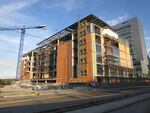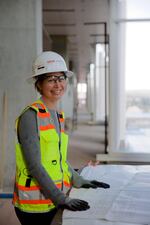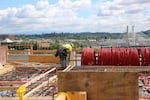
The $190 million new Knight Cancer Institute is rising out of the brownfield just south of I-5 along the Willamette.
Kristian Foden-Vencil / OPB
The physical centerpiece of the new Knight Cancer Institute is a seven-story laboratory in Portland's South Waterfront neighborhood.
Rising from a brownfield, it looks much like any other 21st-century office building in the middle of construction.
But this building is different. And OHSU administrators hope it can help in their $1 billion attempt to cure, or at least better understand, cancer.

OHSU Biologist Tiffani Howard tells builders what scientists want in the new building. She's standing in what she calls 'the collabrador,' a main corridor where scientists will gather to collaborate.
Kristian Foden-Vencil / OPB
In a more traditional construction project, the property owner says what he or she wants, an architect designs the project, a contractor explains why it can’t be done and then everyone goes back to the drawing board.
“And the cycle goes on a few times, and usually what happens is the owner ends up with something less than they originally thought they were going to get. Or they put up a lot more money to get the job done,” said Tiffani Howard, a biologist with OHSU.
Howard has been given the job of telling builders what scientists at the Knight Cancer Institute do and don’t want in their new research home. She's helping lead a different sort of process.
Because the new institute will be packed with labs, computers and other high-tech facilities, the architects brought in all the electricians, plumbers and contractors in on the initial computer design process. Even the guy who would eventually hang the drywall was involved in early conversations.
“He can sit next to the architect and tell the architect, ‘You know, if you just move that wall over just another two inches, that’s going to save us half an hour in eight places on every floor in this building,’" Howard said. "And in the end, we’re going to save money and save time."
She estimates bringing everyone in on the early design process helped add an extra 40,000 square feet of lab space.
Building manager Ed Trotter walks to an area on the second floor where the laboratories are beginning to take shape. There’s a spaghetti junction of vents and conduit hanging from the ceiling. Such a complex web would have taken months to install before computer design.
But now everything is delivered in ready-made sections.
“They fabricated them in a shop off-site. They rolled them in the building. They sucked them up onto the ceiling, and they hung them in place," he said. "It’s a much more controlled environment. They can work during the winter when we’re fighting snow and all that. They’re in nice protected areas."

Construction worker installs the interior wiring, ducting and other technologies that were designed before construction in a computer. Developers say savings helped them add 40,000 sq ft.
Kristian Foden-Vencil / OPB
While new construction techniques are cool, what interests OHSU is a building that encourages scientists from different disciplines to have impromptu conversations — the kind that can lead to unexpected discoveries.
That’s why the building’s been designed with one large primary corridor.
“Often in building, there are all sorts of back ways to get in and out of your office so you can sneak in and sneak out, and nobody ever sees you," Howard said. "What we did was create this kind of primary corridor where you have to move from the lab spaces and office spaces into the center of the building in order to enter and exit. That just creates a real opportunity for people to run into each other."
Early in the process, designers conducted a "shadowing experiment," where they tracked scientists to see what they did all day. The research subjects spent a lot of time in their labs or at their computers. But they also wasted a lot of time looking for places to collaborate.
So the new building will have a large central kitchen, a big open stairwell, a coffee shop and labs with small seating areas, all spots for 600 people to get together to talk. It's like any other modern office space, except in this case, the coworkers will be trying to solve one of the world's greatest scientific problems.
“I think I can claim being the strongest champion for having a little pub on the roof,” said Tom Beer, the center's deputy director. “I thought that was a really important place for people to gather informally and exchange ideas.”
A “little pub” complete with million-dollar views of Mount Hood and the Willamette River.
Cancer research has traditionally been divided into areas of the body — so the study of breast cancer, lung cancers and leukemia are their own disciplines. But in this building, disciplines will be split into different areas.
The tissue department, for example, will be located near the pancreas research area because those cancers develop in similar ways, and researchers can share equipment.

The roof of the new Knight Cancer Institute will have a little pub where researchers can collaborate and enjoy the million dollar views of Mount Hood and the Willamette.
Kristian Foden-Vencil / OPB
People who deal with blood or liquid cancers, such as leukemia and lymphoma, will also work close together.
“It’s not so much where it is in in the body, but it’s more about how the cancer develops and how it metastasizes,” Howard said.
The hope is that looking at things differently will spur advances.
The new $190 million institute is likely to become one of the hubs of Portland’s new "innovation quadrant," part of an area near each end of the Tilikum Crossing where OHSU, Portland State, OMSI and Portland Community College hope to create a critical mass of scientific excellence.
